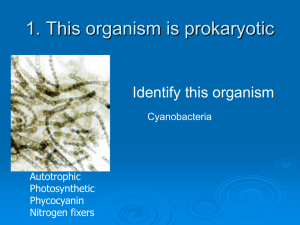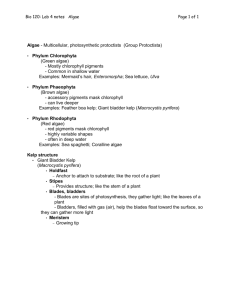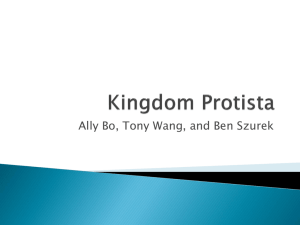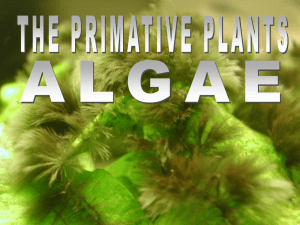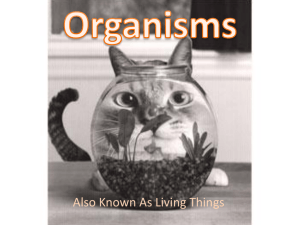golden algae
advertisement
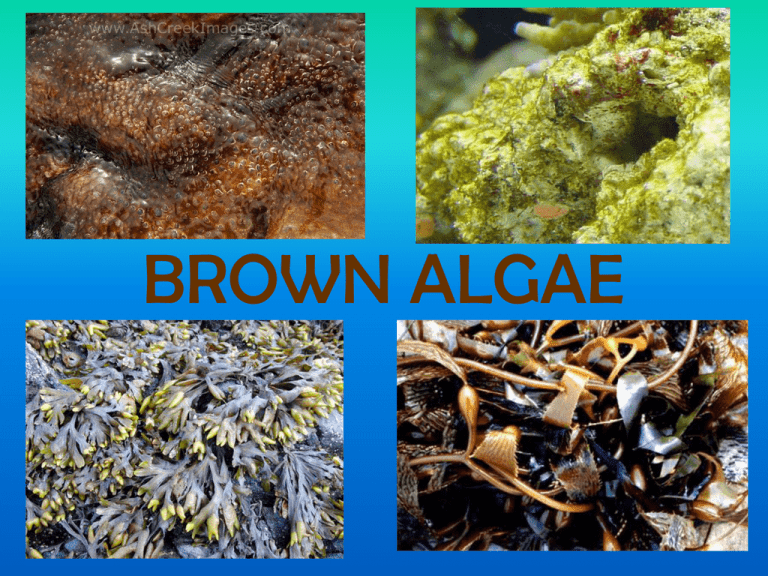
BROWN ALGAE Kingdom: Protista Grouped under: Stramenophila (because they are aquatic) EX: golden algae, diatoms , water molds. Phylum: Phaeophyta BROWN ALGAE: • 1500 species multi-cellular Protista • Are located in rocky shores in North America SEA WEED KELP SAGRASSO WEED STRUCTURE: Usually in large kelp forest. 100 meters Hold fast Flattened blades Stalks NUTRITION AND REPRODUCTION: The mode of nutrition is photosynthesis in order to produce its own energy. 6CO2 + 6H2O + Energy C6H12O6 + 6O2 Brown algae’s life cyle is alternated and reproduces Through What is known as aleternation of generation. Which means the plant alternates between sexual and Asexual in genrations. gametophyte: The gamete-bearing individual or phase sporophyte: The spore-producing individual Ecological Significance: Besides food…. Serve as base of food web in the ocean Holds a lot of iodine Used in commercial use Provides home to many species in the sea Cystoseira or Cystoseira osmundacea Kingdom:Protista Phylum: Phaeophyta Order: Fucales Family: Cystoseiraceae Found in temperate oceans Pacific Mediterranean and Indian Ocean. Autotroph. Provides Food And Habitat to many. Peacock's Tail or Padina pavonica Kingdom:Protista Phylum: Phaeophyta Order: Dictyotales, Family: Dictyotaceae Found in tropical and temperate waters worldwide. Autotroph. medicinal remedies and several cosmetic solutions, can improve skin tone and texture, reduce wrinkles, and support bone and cartilage health. Turbinaria Ornata Kingdom: Protista Phylum: Phaeophyta Order: Fucales, Family: Sargassaceae Found in subtropical and tropical regions of the Pacific and Indian Ocean. Can survive extreme conditions. Found in clusters. Autotroph,strong biotechnological potential GOLDEN ALGAE Kingdom: Protista Grouped under: Stramenophila Phylum: Chrysophyta (Categorized with Diatoms but the difference is it holds yellow, brown carotenoid and Xanthophyll in pigment in Chloroplast) GOLDEN ALGAE: Are unicelular protist. Ususally in colonies. There are two tyes: freshwater chrysomonads and marine silicomonads. STRUCTURE: Cell with two flagella's for locomotion. Size of a human body cell. NUTRITION AND REPRODUCTION: Golden algae is photosynthetic,(autotroph) but can change to a heterotroph if sunlight is low feeding on Diatoms and Bacteria. Reproduction of Golden Algae is through asexual reproduction by cell division. ECOLOGICAL SIGNIFICANCE: Is known to kill fishes by the toxins that is released(such as magnesium [Mg] and calcium [Ca]), basically cutting the oxygen in gills. As well as plants preventing enough sunlight to teach the plants. But shown to have no harm toward wildlife and humans. Ochromonas Kingdom: Protista Phylum: Chrysophyta Family: Ochromonadaceae Freshwater.Have to unequal Flagellas. Heterotrophic. Dinobryon Kingdom: Protista Phylum: Chrysophyta Order: Chromulinales Family: Dinobryaceae Can be found in both freshwater and salt. Composed of cellulose. Grow in branch like colonies. Reprouce asexually. Have an increase diversity, increases vulnerability to disease or pest. Diatoms Structure • • • • • • • • • Shape: - Centric and Pennate Centric may be circular, triangular, or rectangular. Pennate diatoms are elongated. Some diatoms link together to form chains or aggregations of multiple individuals of the same species. Parts of organism: - Made up of protoplasm which includes the cell’s nucleus, chloroplasts, and • oil globules. • Single-celled Diversity • • • • Kingdom- Protista Grouped under: Stramenophila Phylum: Bacillariophyta Manufacture the carbohydrate chrysolaminarin, unique double shells of silica, contain chlorophylls a and c. Nutrients and Reproduction • Most photosynthesize but the few that don’t live on dissolved nutrients from rich organic matter. • Reproduce asexually and sexually. They can divide by mitosis or produce and egg and sperm through meiosis. Ecological Significance • Diatoms are estimated to be responsible for 20% to 25% of all the organic carbon fixation, are major sources of atmospheric oxygen, and are a major food source for aquatic microorganisms and insect larva. Water Molds Structure • Shape: Filamentous • Single-celled • The one’s that produce sexually have specialized regions that produce specific male or female parts. Diversity • • • • • Kingdom: Protista Grouped under: Stramenophilla Phyla: Oomycetes Characteristics: Terrestrial and freshwater Examples: water molds, rusts, and mildew Nutrition and Reproduction • They obtain energy by decomposing organic materials. • Reproduce asexually through spores which may be of two types, pear-shaped with twp apical whiplike structures (flagella) or kidneyshaped with two flagella on the concave side. • Sexually, through fusion of gametes. Ecological Significance • Water molds play an important role in the decomposition and recycling of decaying matter. • The Irish potato famine was caused by water mold. Choanflegellida Are single-celled or can be colonial, distinguished by a thin protoplasmic collar at the anterior end. Contain a single emergent flagellum surrounded by a funnel-shaped, contractile collar Reproduce by simple cell division • Found in fresh water and Oceans. • Microvilli, or slender fingerlike projections, that surrounds the single flagellum by which choanoflagellates both move and take in food • Choanoflagellates are almost identical in shape and function with the spongethese cells generate a current that draws water and food particles through the body of a sponge, and they filter out food particles with their microvilli. Choanoflagellate-like cells are also found in other animal phyla; in organisms such as flatworms and rotifers, for instance, choanoflagellate-like cells are found in flame bulbs that act as excretory organs • best living examples of what the ancestor of all metazoans may have looked like. • • • • • • • • • • • • • • • • • • • • • • • • • • • Works Cited of Pictures www.ashcreekimages.com www.dreamstime.com www.giapo.com http://www.whateats.com/what-eats-kelp http://www.greenguidespain.com/andalucia/2010/07/seaweed-the-next-biodiesel/ http://www.superstock.com/stock-photos-images/4201-19552 http://www.amnh.org/exhibitions/permanent/ocean/02_ecosystems/02c2_algae.php http://www.geog.utas.edu.au/kelpwatch/facts_b.html http://medicinalherbinfo.org/herbs/Kelp.html http://thekelpbed.com/about-2/ http://www.botany.hawaii.edu/faculty/webb/BOT311/Phaeophyta/PhaeophytaSexRepro2.htm www.Deep-blue-water.com http://wilderweb.wordpress.com/ http://lovingthebigisland.wordpress.com/2009/04/21/hidden-secrets-of-hawaii-the-golden-ponds-of-ke-awaiki/egolden-ponds-underwater-ii/ http://www.racerocks.com/racerock/tidepool/pool4/pool4.htm http://lovingthebigisland.wordpress.com/2009/04/21/hidden-secrets-of-hawaii-the-golden-ponds-of-ke-awaiki/egolden-ponds-underwater/ http://www.art.com/products/p360636849-sa-i4010093/philip-sze-synura-is-a-chrysophyte-or-golden-brownalgae.htm http://www.sciencephoto.com/media/118225/view http://www.trueknowledge.com/q/facts_about__golden_algae http://aquaplant.tamu.edu/plant-identification/alphabetical-index/golden-alga/ http://micropolitan.org/photomicro/1/frame7.html http://www.tpwd.state.tx.us/landwater/water/environconcerns/hab/ga/workshop/where.phtml http://www.downtoearth.org.in/content/science-technology-briefs http://mysteryoftheinquity.wordpress.com/2011/03/23/massive-death-connections-pt4/ • Bibliography • Section B-Brown Algae . (2001). Retrieved Feburary 20, 2012, from Reef Education Network: http://www.reef.edu.au/asp_pages/secb.asp?FormNo=6 • Kelp. (2007, June 14). Retrieved feburary 20, 2012, from Biology Online : http://www.biology-online.org/articles/kelp.html • Albers, J. (n.d.). How Do Algae Reproduce? Retrieved feburary 20, 2012, from EHow: http://www.ehow.com/how-does_4574307_algaereproduce.html • Department, T. P. (n.d.). Biology of Golden Alga, Prymnesium parvum. Retrieved feburary 20, 2012, from Texas Parks and Wildlife : http://www.tpwd.state.tx.us/landwater/water/environconcerns/hab/ga/bi o.phtml • Golden alga frequently asked questions. (n.d.). Retrieved feburary 20, 2012, from Arizona Game and Fish Department : http://www.azgfd.gov/temp/golden_alga_faqs.shtml#8 • Johnson, R. &. (2002). Protists. In R. &. Johnson, Biology (pp. 704-709). New York. NY: McGraw-Hill Companies Inc. • Sandhyarani, N. (2011). Reproduction of Algea . Retrieved Feburary 20, 2012, from Buzzle.com: http://www.buzzle.com/articles/reproduction-inalgae.html
